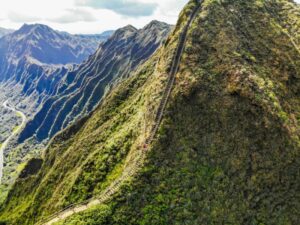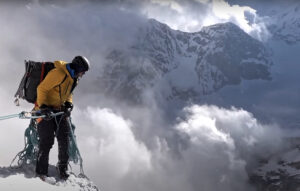BASE jumper, skier and former world champion sport climber Liv Sansoz has survived several close calls, paid a high toll in injury and grappled with the emotional freight of the dark side of the mountains. Some years, the French star totally fell off the radar as she dealt with rehab and friends’ deaths. Now Sansoz has reemerged, fresh from summiting all 82 of the 4000’ers in the Alps and with a new approach for 2019.
In the late 1990s, you were a two-time world champion sport climber. Recently, you completed all 82 4000’ers in the Alps. What were you up to in the years in between?

Crossing the summit ridge of the Grünhorn. Photo: Ben Tibbetts
I’ve been in the mountains as long as I can remember, skiing since I was 2 years old and hiking with my parents. I grew up reading books of pioneer alpinists. I climbed Mont Blanc at 14 and started paragliding at 15. Mountains are my life. At 16, I started rock climbing and soon I joined French national team. Now, climbing competition demands full commitment. You need to focus 100 percent on it if you really want the best results, so I sort of abandoned everything else. I didn’t even ski much for fear of getting permanently injured or jeopardizing my training level.
In 2001, I was working on “Necessary Evil” (8c+/15.14c) in the Virgin River Gorge in Arizona as part of a film. That day, none of my friends were available to belay me, so I was belayed by some friend of the film crew. While warming up on a 7a/7a+, she just made a mistake, let the rope go, and I crashed on to the ground. I broke a vertebra and suffered pain for months. I was not that badly injured, physically at least, but I was emotionally shocked. I realized that I had almost died there. And my confidence was shattered.
After that, everything changed. I tried to climb again, but nothing seemed to work. I was not really motivated, and I wasn’t enjoying it. I felt nothing good from climbing, not to mention how picky I became about those belaying me. At a certain point, I decided to just let it go. “If climbing is really my passion, eventually I’ll climb again,” I told myself. “Otherwise, there are other things to do.”
I finished my studies and took up different sports, including skydiving. By 2005, I felt strong, confident and willing to climb again. True, competition was not an option any more, but I hit the crags again and got back in shape pretty soon. I turned to traveling to climbing spots around the world, discovered some beautiful places and absorbed different styles of climbing from fellow climbers. Of course, I went to Yosemite. There, with the sheer wall of El Capitan under my feet, I felt the call of BASE jumping. You see, I couldn’t help thinking, “If I could just push on my legs and jump … That would be really, really nice.” Then the feeling repeated at the Verdon Gorge. So I met some people, asked questions and focused on skydiving to train for BASE jumping. I made my first jump from a bridge, then from a cliff in Norway, then I jumped from the summit of the Eiger.

Liv Sansoz. Photo: Ben Tibbets
For years, I jumped a lot and climbed peaks in order to jump from the summit, and then … then I had another accident. Totally my fault, this time. And a very serious one. Broke my pelvis and sacrum bone, underwent two major surgeries and had to lay on my back, still, for three months. It was tough, it was long, but I also had plenty of time to think. And to dream of new plans. As soon as I stared walking again, my doctor allowed me to substitute outdoor training for indoor rehab: from short walks to hiking, then back to mountaineering and skiing. And I moved to Chamonix. For those of you who’ve been there, you’ll know it’s common to see paragliders in the air every day. It was only logical that I resumed flying. I analyzed my accident, came to terms with my mistake and got over it. As soon as I had the screws removed, I return to skydiving. By now, it was 2014. Everyone was into wingsuiting. And so I did it too. At the same time, losing friends became scarily frequent. Then Stephanie Davis’s boyfriend Mario Richard died. He was a very close friend and it came as an unexpected shock. I thought, “Well, if Mario has died, I may well be next.” The following morning, I sold all my jumping gear online.
You didn’t even keep the wingsuit as a souvenir?
Certainly not. I had to get rid of everything for good, to avoid temptation. Wingsuiting is so addictive that if you have a chance, you’ll jump again.
But I reflected and thought: “Okay, so I’ve done this, I know how it feels, but I don’t need it to be happy, so away with it.
Just out of curiosity, did it sell well?
Sure, right away!
And how did you feel then?
Free! Free, and happy. I was sure that it was the best decision I could have made. In fact, rather than the sport itself, what I miss most is the people, the friends I’d made who kept jumping. But well, I also know skiers, climbers, paragliders … and I still keep in touch with the really good friends I made in the wingsuit community.

Climbing the Zmutt route on the Matterhorn. Photo: Ben Tibbetts
Then you focused on alpinism…
Eventually, yes. The problem was that, after all that time lying still, my bones had somehow gone weak, and I had a number of injuries and breakages in silly accidents, such as tripping down stairs or slipping while on the street. From 2011 to 2015, I nearly always had something broken or was in rehab. Frustrating, indeed. But I did some cool things, such as help a disabled friend of mine climb El Cap. I managed to participate in a couple of expeditions to Patagonia and China, but it was hard to focus on myself, apart from wondering when and where I’d have my next injury.
Are you feeling better now?
Yes. I finally managed to improve by following the advice of experts who ran some tests. They suggested that I had to change my diet. I followed their recommendations strictly for three years, and the results have been amazing.
Tell us about this latest project, climbing all 82 of the 4000’ers in the Alps. It’s a rare goal but others have done it first, so you’ve focused on style, beginning from the valley floor, not using lifts, and combining walking, climbing, skiing and paragliding, right?

On crevassed terrain between Jungfrau and Mönch in the Swiss Alps. Photo: Ben Tibbetts
Yeah, I wanted to do it my way. My friend Ueli (Steck) did it in only 62 days. It’s been done in winter solo, Patrick Berhault tried to complete the feat in 82 days and died trying, etc. But I am not Ueli Steck, I am not Kilian Jornet, I am just myself and I wanted to do this the way I liked. I also wanted to share it with good friends. In all, 22 friends helped me climb the 82 peaks. Everyone was delighted to join, and we were always full of energy. It brought me a lot of joy. I thought it would be cool to try and climb all the 4000’ers with just our two legs, from valley floor to summit. For some peaks, that wasn’t a big deal, but on others, the experience changed a lot. Also, this tactic let us climb mountains when the lifts weren’t working, which provided wilder scenery and atmosphere.

Skiing the Oberland, on the approach to Jungfrau, in the Swiss Alps. Photo: Ben Tibbetts
Looking at the pics and your social media posts, the whole project look so… fun! It seemed to be totally different from the ”art of suffering” in the Himalaya. Speaking of which, have you considered high-altitude mountaineering?
Maybe in the past I would have liked the idea of climbing an 8000’er. Now, if I really considered such a feat, I would want to do it without O2, and then I would have to struggle at that super-slow pace while those on O2 passed me by, which would be rather depressing. And then, there’s the financial aspect: These expeditions are so expensive! Finally, I like the flexibility of shorter climbs. If the weather is bad in the Alps, you can always go climbing on a crag, or flying, or hiking lower down the valley. In the Himalaya, however, once you get to base camp, there are no options other than wait out the bad weather.
That said, I’m not discarding the Himalayan idea altogether. Lately, I’ve considered venturing up some 6,000m peak, something less tall but a bit more technical than walking on snow, and combining the ascent with a paragliding descent.
How about a first ascent on some unclimbed mountain?
Climbing a new mountain would be really exiting, but such a project should be organized and done with the right people and the right approach. During this latest project in the Alps, I became convinced that for me, things need to stay simple, light and fun. I keep those three words in mind as a mantra nowadays.






